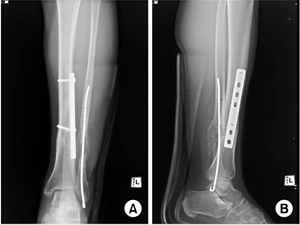J Korean Fract Soc.
2013 Apr;26(2):147-150. 10.12671/jkfs.2013.26.2.147.
Extensive Metallosis Caused by Plate and Screw Construct for Distal Fibular Fracture - A Case Report -
- Affiliations
-
- 1Department of Orthopedic Surgery, Chonbuk National University Hospital, Chonbuk National University Medical School, Gwangju, Korea. osdr2815@naver.com
- KMID: 1496170
- DOI: http://doi.org/10.12671/jkfs.2013.26.2.147
Abstract
- Metallosis has been reported in the setting of weight-bearing joint arthroplasties, like the hip and knee joints. However, the prevalence of metallosis in non-articular portions is very uncommon. We report a rare case of a patient who had metallosis secondary by fibular nonunion after fixation with plate and screw. In addition, we discuss the clinical and the operative findings, as well as the outcome of this uncommon complication.
Figure
Reference
-
1. Berry DJ, Barnes CL, Scott RD, Cabanela ME, Poss R. Catastrophic failure of the polyethylene liner of uncemented acetabular components. J Bone Joint Surg Br. 1994. 76:575–578.
Article2. Bullough PG. Metallosis. J Bone Joint Surg Br. 1994. 76:687–688.
Article3. Case CP, Langkamer VG, James C, et al. Widespread dissemination of metal debris from implants. J Bone Joint Surg Br. 1994. 76:701–712.
Article4. Chang JD, Lee SS, Hur M, Seo EM, Chung YK, Lee CJ. Revision total hip arthroplasty in hip joints with metallosis: a single-center experience with 31 cases. J Arthroplasty. 2005. 20:568–573.5. Danzig LA, Woo SL, Akeson WH, Jemmott GF, Wickham MG. Internal fixation plates after fifty-six years of implantation: report of a case. Clin Orthop Relat Res. 1980. 149:201–206.6. De Smet L. Metallosis mimicking osteomyelitis from a forearm plate retained for 50 years. Acta Orthop Belg. 2000. 66:289–291.7. Huo MH, Romness DW, Huo SM. Metallosis mimicking infection in a cemented total knee replacement. Orthopedics. 1997. 20:466–470.
Article8. Khan RJ, Wimhurst J, Foroughi S, Toms A. The natural history of metallosis from catastrophic failure of a polyethylene liner in a total hip. J Arthroplasty. 2009. 24:1144.e1–1144.e4.
Article9. McGovern TF, Moskal JT. Radiographic evaluation of periprosthetic metallosis after total knee arthroplasty. J South Orthop Assoc. 2002. 11:18–24.10. Tan GM, Lynne G, Sarbjit S. Osteolysis and wear debris after total knee arthroplasty presenting with extra-articular metallosis in the calf. J Arthroplasty. 2008. 23:775–780.
Article
- Full Text Links
- Actions
-
Cited
- CITED
-
- Close
- Share
- Similar articles
-
- Posterior Plating in Distal Fibular Fracture
- Rupture of the Extensor Pollicis Longus Tendon at the Proximal Screw of Volar Plate Fixation for Distal Radius Fracture: A Case Report
- The Posterior Plate for Distal Fibular Fixation
- Result of Fibular Fixation Using Screw in Ankle Fracture
- Operative Treatment with Plate Screw Devices for Distal Femoral Fracture






